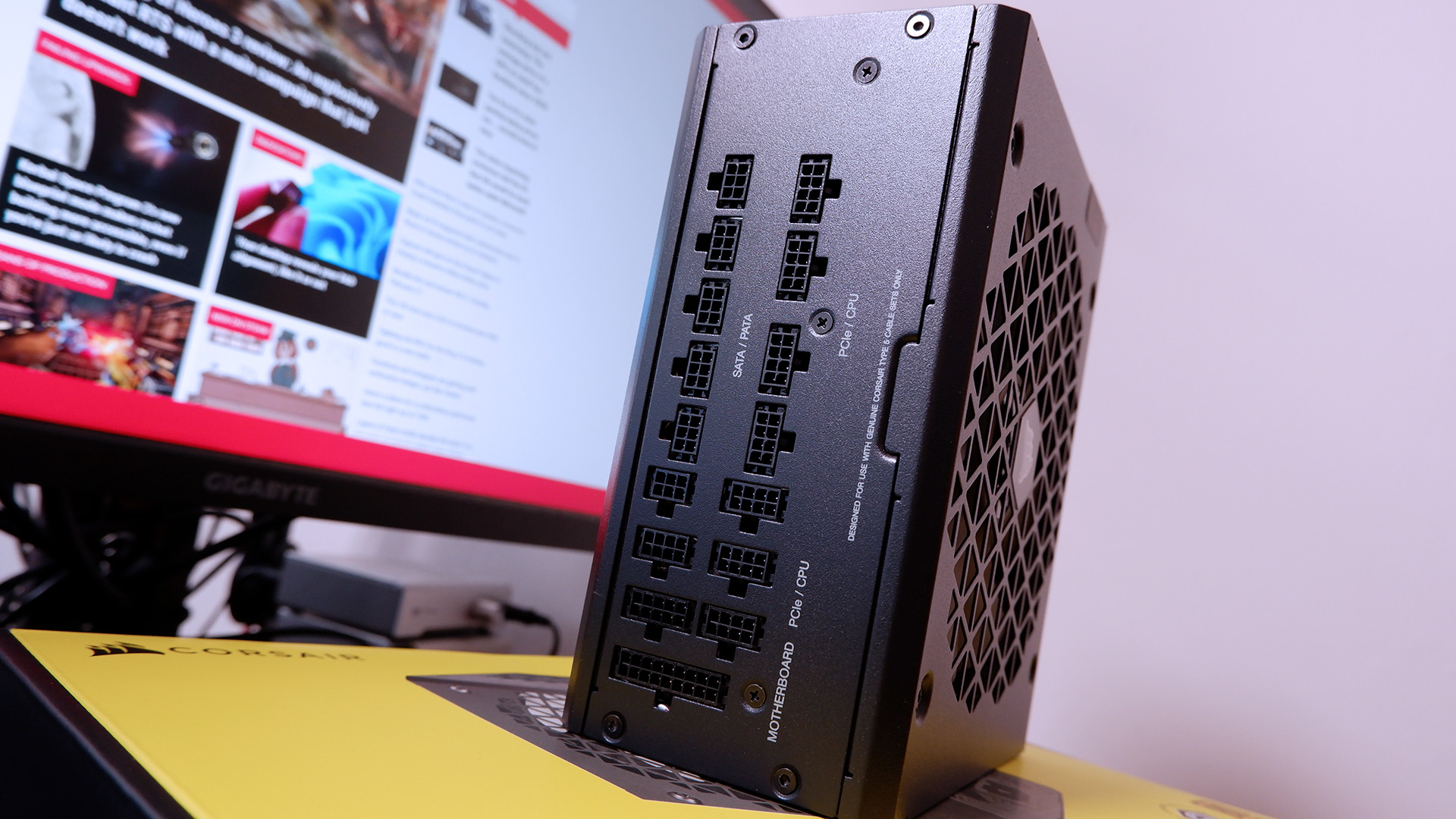
I am sold on the Corsair RM1200x SHIFT power supply after installing it in my machine.
Corsair’s done the impossible: it has made an actually exciting new power supply. To achieve this magnificent feat, it’s taken all the connectors, shrunk them down, and moved them to the side of the PSU. No, the other side. The end result is a PSU that’s extremely easy to build with, providing you have the right case.
Luckily, I have just that: the Corsair iCUE 5000T. This standard mid-tower is the perfect candidate in which to try out Corsair’s newfangled power supply. There’s ample room out from the side panel for the power cables to extend from their oddly-place connectors, around two inches, and the PSU mounts traditionally with the fan facing downwards.
I suspect many common case designs will work with the RMx SHIFT lineup, though, as I found out when looking at the NZXT H9 Elite, not all are suitable. In that case, the fan on the SHIFT is either facing the motherboard tray, or the side-loaded cables are inaccessible due to the PSU support bracket. That’s a no-go.
The 5000T is a great fit, however. Inside that case currently resides an EVGA G2 850W power supply I’ve used in one build or another for around half a decade. Definitely time to swap that out. Since I’ve also had the monstrous Gigabyte Aorus P1200W in this machine—a PSU with an actual programmable screen on it—and I have an AMD RX 7900 XTX waiting to be installed, I’ve opted for the highest wattage RMx SHIFT PSU to replace the 850W G2.
That’s the RM1200x SHIFT. It’s an 80 Plus Gold certified power supply rated to Cybenetics Gold for efficiency and Cybenetics A for noise by our pal Aris Mpitsiopoulos. You can check out a short version of the Cybernetics evaluation [PDF] for yourself if you want a deeper dive on the details. One key takeaway is the RM1200x SHIFT uses the same OEM, Channel Well Technology (CWT), as the Corsair RMx (2021) lineup we currently rate as the best PSU for gaming.
Micro-fit connectors are actually super cute. (Image credit: Future)
With the RM1200x SHIFT deemed worthy for my rig, it’s time to unpack this marvel. Inside the box you’ll find the PSU, a slightly shoddy-looking pack of loose cables, and a wall outlet cable.
It’s an odd-looking power supply. Not only because all the connectors have been cut and pasted onto the length of it, but also as it’s replete with micro-fit connectors. Each of the many cables that plug into it are miniaturised versions of those we’ve come to expect from most power supplies these days, and the four-pin micro-fit SATA is especially sweet—it looks like it comes from a build your own PC set for kids.
While these micro-fit connectors serve to save space on the PSU, this is an ATX 3.0 power supply and, as such, comes with a single PCIe 5.0 12VHPWR cable in the box to hook up a high-end RTX 40-series graphics card. There are also eight PCIe 6+2 pin connectors (four dual/four single) for everything else, including the RX 7900 XTX I’ll be installing.
Onto the build; the first step is removing the 850W G2. With that done and both power supplies side-by-side, you get a better feeling for the scale of the micro-fit connectors on the RM1200x.
On the left: Corsair RM1200x SHIFT. On the right: EVGA G2 850W. (Image credit: Future)
Next up, loading the RM1200x SHIFT into the machine. This is where my build process first differs with the SHIFT versus a standard PSU form factor. Usually, I’d recommend allocating the cables you need for your PC and plugging them into the PSU before loading them into a chassis. That way, you don’t have to mess around with hard-to-reach connectors or awkward cable runs after the fact. That’s not necessary with the SHIFT.
All that is needed with the SHIFT is to orient it the right way up (in my case, with the fan facing down) and screw it in. It’s not much of a time saver, but it makes switching around cables for adding or removing parts down the line much easier.
(Image credit: Future)
Now it’s time to grab your cables and one-by-one plug them in. Taking note, of course, of how cute the tiny SATA cable is once again.
(Image credit: Future)
With everything plugged in it’s onto cable management. Not my forte, admittedly, but cable management is made easier by the straight cables running off the side of the RM1200x SHIFT. There’s less of a stretch for the pesky CPU power cable, which solves one bugbear of mine, and plugging in another SATA cable for an easier run to my rear-mounted SSDs is a piece of cake.
I’m done in remarkable time, and what’s more impressive is I’m not cursing a cable or missing connector at the end of it. The whole build process is a breeze, absolutely made easier by the shifted power connectors.
(Image credit: Future)
There’s no need to bend the cables all that much to comfortably close the side panel, which was a part of the build I was initially worried about due to developments regarding the 12VHPWR connector. If you intend to pick up this PSU you’ll need to pay close attention to the gap between the PSU and the side panel to ensure the same goes for your build, however.
It’s not the prettiest cable management but the PSU is installed and the PC boots. (Image credit: Future)
What started out as a fun concept I was tentatively excited for I’ve become a firm fan of. This whole power supply replacement has no doubt been my easiest to-date, and if you’re regularly ripping out components like I am then the RM1200x SHIFT will continue to be useful. I admit the utility of this PSU is dependent on your case and if you’re going to swap out your components all that often. If you’re likely going to install a PSU once then not touch it for five years, there’s less reason to take a punt on a non-standard design such as this, which will ultimately limit your choice of chassis.
Though for simply offering something different in the power supply world, I’m all for the RM1200x SHIFT.





